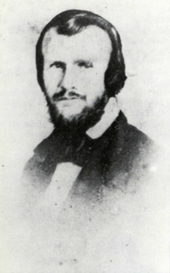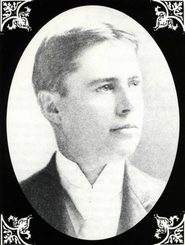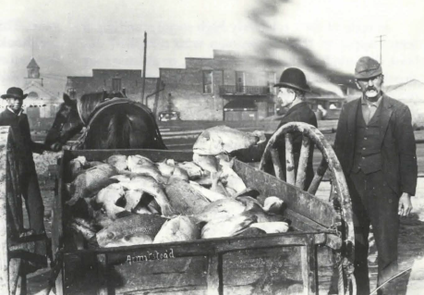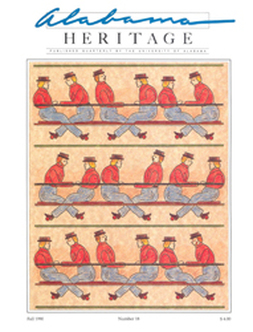|
On the cover: Illustration by Laura Woelfel-Madison based on a contemporary illustration of a Civil War submarine, possible the CSS Hunley.
|
FEATURE ABSTRACTS
 Horace L. Hunley, a New Orleans lawyer and cotton merchant, became fascinated by the prospect of building a submarine capable of sinking an enemy ship. He was involved in financing at least three submarines and finally lost his life in the third one, the CSS Hunley, when it went down in Charleston Harbor with Hunley himself at the controls. (Courtesy U.S. Naval Historical Center)
Horace L. Hunley, a New Orleans lawyer and cotton merchant, became fascinated by the prospect of building a submarine capable of sinking an enemy ship. He was involved in financing at least three submarines and finally lost his life in the third one, the CSS Hunley, when it went down in Charleston Harbor with Hunley himself at the controls. (Courtesy U.S. Naval Historical Center)
The Confederate Submarine H.L. Hunley
By James E. Kloeppel
When the Civil War began, the South possessed not a single naval vessel. To buy time until the Confederacy could build ships and form a navy, Confederate officials encouraged private individuals to use their own resources to capture or destroy enemy vessels and cargo. Two such individuals were Horace L. Hunley and James R. McClintock. These men would prove to be influential in the development of a new form of vessel: the submarine. The history of their submarine, the Hunley is laced with disaster and ends in mystery, but it made an important contribution to the history of naval warfare.
Additional Information
Alexander, W. A. "The Confederate Submarine Torpedo Boat Hunley," The Gulf States Historical Magazine 3 (September 1902): 81-91.
Beard, W. E. "The Log of the C.S. Submarine," U.S. Naval Institute Proceedings 42 (1916): 1545-1557.
Blair, C. H. "Submarines of the Confederate Navy," U.S. Naval Institute Proceedings 78 (October 1952): 1115-1121 .
Bowman, B. ''The Hunley: Ill-fated Confederate Submarine," Civil War History (September 1959): 315-319.
About the Author
Jim Kloeppel, science writer/editor, Georgia Institute of Technology, is the author of Danger Beneath the Waves: A History of the Confederate Submarine H. L. Hunley (Adele Enterprises, 1987). Kloeppel, who studied physics as an
undergraduate at Morningside College in Iowa, has longstanding interests in technology, astronomy, and history. In recent years, he has also become interested in house-building. He and his wife built their own home--it took them five years-doing all the work themselves, including mixing concrete by hand. "We were (and still are) nuts," he says.
By James E. Kloeppel
When the Civil War began, the South possessed not a single naval vessel. To buy time until the Confederacy could build ships and form a navy, Confederate officials encouraged private individuals to use their own resources to capture or destroy enemy vessels and cargo. Two such individuals were Horace L. Hunley and James R. McClintock. These men would prove to be influential in the development of a new form of vessel: the submarine. The history of their submarine, the Hunley is laced with disaster and ends in mystery, but it made an important contribution to the history of naval warfare.
Additional Information
Alexander, W. A. "The Confederate Submarine Torpedo Boat Hunley," The Gulf States Historical Magazine 3 (September 1902): 81-91.
Beard, W. E. "The Log of the C.S. Submarine," U.S. Naval Institute Proceedings 42 (1916): 1545-1557.
Blair, C. H. "Submarines of the Confederate Navy," U.S. Naval Institute Proceedings 78 (October 1952): 1115-1121 .
Bowman, B. ''The Hunley: Ill-fated Confederate Submarine," Civil War History (September 1959): 315-319.
- Campbell, Edward D. C., Jr. "The 'Eccentric Genius' of Conrad Wise Chapman," Virginia Cavalcade 37 (Spring 1988): 158-175.
- Duncan, Ruth H. The Captain and Submarine CSS Hunley (S. C. Toof and Co., 1965).
- Kloeppel, James E. Danger Beneath the Waves: A History of the Confederate Submarine H. L. Hunley (Adele Enterprises, 1987).
- Perry, Milton F. Infernal Machines: The Story of Confederate Submarine and Mine Warfare (Louisiana State University Press, 1965).
- Sims, Lydel. ''The Submarine That Wouldn't Corne Up," American Heritage 9 (1958): 48-51ff.
- Stern, Philip Van Doren. The Confederate Navy: A Pictorial History ( Doubleday & Company, 1962), pp. 172-179.
- Thomson, D. W. "Three Confederate Submarines," U.S.Naval Institute Proceedings 67 (January 1941): 39--47.
- Villard, Oswald Garrison. "The Submarine and the Torpedo in the Blockade of the Confederacy," Harper's Monthly 133 (1916 June): 131-137.
About the Author
Jim Kloeppel, science writer/editor, Georgia Institute of Technology, is the author of Danger Beneath the Waves: A History of the Confederate Submarine H. L. Hunley (Adele Enterprises, 1987). Kloeppel, who studied physics as an
undergraduate at Morningside College in Iowa, has longstanding interests in technology, astronomy, and history. In recent years, he has also become interested in house-building. He and his wife built their own home--it took them five years-doing all the work themselves, including mixing concrete by hand. "We were (and still are) nuts," he says.
 Playwright Augustus Thomas (1857-1934), who made abundant use of American subject matter in his productions, enjoyed his first popular success with Alabama (1891). He is pictured at age 31, one year before he wrote Alabama. (Courtesy The Print of My Remembrance by Augustus Thomas, 1922)
Playwright Augustus Thomas (1857-1934), who made abundant use of American subject matter in his productions, enjoyed his first popular success with Alabama (1891). He is pictured at age 31, one year before he wrote Alabama. (Courtesy The Print of My Remembrance by Augustus Thomas, 1922)
Alabama: The Play
By Charles S. Watson and Jennifer Willard
Alabama, by Augustus Thomas, was produced in 1891. It was not the first American play to use local settings and dialect, but it was immensely popular. This melodrama, though innocent of sophistication, is significant. Between its yellowed pages of sentimental dialogue and musty humor lies a message of goodwill and hope for a nation striving to reunite after a brutal Civil War. This article examines the inception, production, and legacy of this play.
Additional Information
Going, William T. "The Prestons of Talladega and the Hubbards of Bowden: A Dramatic Note" in Essays in Alabama Literature (University of Alabama Press, 1975), pp. 142-55 .
Hoole, W. Stanley. "Alabama Drama of Reconciliation," The Alabama Review, 19 (1966): 83-103.
Moses, Montrose J. The American Dramatist (Little, Brown, 1925).
Quinn, Arthur Hobson. A History of the American Drama from the Civil War to the Present Day (Appleton-Century Crofts,1936).
About the Authors
Charles S. Watson, professor of English at the University of Alabama, teaches courses in modem drama, American literature, and Southern literature and is the author of Antebellum Charleston Dramatists (University of Alabama Press, 1976). A native of Anderson, South Carolina, Watson credits his initial interest in drama to his aunt, Dorothy Sullivan
Townsend, who directed the Little Theatre of Anderson and played in such roles as "Birdie" in The Little Foxes.
Jennifer Willard is arts editor/writer for the University of Alabama News Bureau and the College of Arts and Sciences, editor of the Society for the Fine Arts Review, and promotion director of Alabama Heritage. Her fascination with the theatre began at the age of six when her father took her to a college performance of The Boyfriend. Since then she has been a performer, producer, and administrator for countless professional and amateur theatrical productions. "Show business is my life," shrugs Willard.
By Charles S. Watson and Jennifer Willard
Alabama, by Augustus Thomas, was produced in 1891. It was not the first American play to use local settings and dialect, but it was immensely popular. This melodrama, though innocent of sophistication, is significant. Between its yellowed pages of sentimental dialogue and musty humor lies a message of goodwill and hope for a nation striving to reunite after a brutal Civil War. This article examines the inception, production, and legacy of this play.
Additional Information
Going, William T. "The Prestons of Talladega and the Hubbards of Bowden: A Dramatic Note" in Essays in Alabama Literature (University of Alabama Press, 1975), pp. 142-55 .
Hoole, W. Stanley. "Alabama Drama of Reconciliation," The Alabama Review, 19 (1966): 83-103.
Moses, Montrose J. The American Dramatist (Little, Brown, 1925).
Quinn, Arthur Hobson. A History of the American Drama from the Civil War to the Present Day (Appleton-Century Crofts,1936).
- Thomas, Augustus. Alabama: A Drama in Four Acts (The Dramatic Publishing Company, 1898).
- Thomas, Augustus. The Print of My Rememberance (Charles Scribner's Sons, 1922).
About the Authors
Charles S. Watson, professor of English at the University of Alabama, teaches courses in modem drama, American literature, and Southern literature and is the author of Antebellum Charleston Dramatists (University of Alabama Press, 1976). A native of Anderson, South Carolina, Watson credits his initial interest in drama to his aunt, Dorothy Sullivan
Townsend, who directed the Little Theatre of Anderson and played in such roles as "Birdie" in The Little Foxes.
Jennifer Willard is arts editor/writer for the University of Alabama News Bureau and the College of Arts and Sciences, editor of the Society for the Fine Arts Review, and promotion director of Alabama Heritage. Her fascination with the theatre began at the age of six when her father took her to a college performance of The Boyfriend. Since then she has been a performer, producer, and administrator for countless professional and amateur theatrical productions. "Show business is my life," shrugs Willard.
 Mobile cartmen with a load of fish, 1895. Most of the catch is red snapper, including the find specimen being held up for the camera. (Courtesy T.E. Armistead Collection, University of South Alabama Archives)
Mobile cartmen with a load of fish, 1895. Most of the catch is red snapper, including the find specimen being held up for the camera. (Courtesy T.E. Armistead Collection, University of South Alabama Archives)
Excerpts from the 1878 Gulf City Cook Book
With an introduction by George H. Daniels
In the fall of 1990, the University of Alabama Press reprinted a cookbook published in 1878 by the women of the St. Francis Street Methodist Church, Mobile. The new editions, with an introduction by George H. Daniels, is a volume in the Library of Alabama Classics, a series begun by the press in 1982 and designed to make available to the public the most engaging and provocative publications of the state's past. A portion of Professor Daniels's introduction is reprinted here, as are selected recipes.
Additional Information
About the Author
George Daniels is professor and chair, Department of History, University of South Alabama. He is also an award-winning cook. "I collect cookbooks," he says, ''both old ones and recent ones that exemplify regional or national specialities, and I create my own recipes based on inspiration that I get from them--in culinary history, there is nothing really new." A current favorite recipe which Daniels plans to enter in a seafood contest is an eggplant and shrimp curry
that he describes as "a cross between Cajun and Indian in inspiration." Last year, Daniels received an award in the same contest with a grilled shark steak in savory tomato sauce. Daniels has tried many of the recipes in the Gulf
City Cook Book, but he has never fried an eel. "It's not that I wouldn't," he says, "the chance just hasn't come up."
With an introduction by George H. Daniels
In the fall of 1990, the University of Alabama Press reprinted a cookbook published in 1878 by the women of the St. Francis Street Methodist Church, Mobile. The new editions, with an introduction by George H. Daniels, is a volume in the Library of Alabama Classics, a series begun by the press in 1982 and designed to make available to the public the most engaging and provocative publications of the state's past. A portion of Professor Daniels's introduction is reprinted here, as are selected recipes.
Additional Information
- Axford, Lavonne B. English Language Cookbooks,1600-1973 (Gale Research Co., 1976).
- Egerton, John. Southern Food (Knopf, 1987).
- Henderson, Mrs. Mary F. Practical Cooking and Dinner Giving (Harper & Brothers, 1876).
- Henderson, W. A. Common Sense in the Kitchen (Hurst & Co., 1870).
- Panschar, William G. Baking in America, vol. 1 (Northwestern University Press, 1956).
- Weigley, Emma Seifrit. Sarah Tyson Rorer: The Nation's Instructress in Dietetics and Cookery (American Philosophical Society, 1977).
- Wilcox, Estelle Woods. Buckeye Cookery and Practical Housekeeping (Buckeye Publishing Co., 1877).
About the Author
George Daniels is professor and chair, Department of History, University of South Alabama. He is also an award-winning cook. "I collect cookbooks," he says, ''both old ones and recent ones that exemplify regional or national specialities, and I create my own recipes based on inspiration that I get from them--in culinary history, there is nothing really new." A current favorite recipe which Daniels plans to enter in a seafood contest is an eggplant and shrimp curry
that he describes as "a cross between Cajun and Indian in inspiration." Last year, Daniels received an award in the same contest with a grilled shark steak in savory tomato sauce. Daniels has tried many of the recipes in the Gulf
City Cook Book, but he has never fried an eel. "It's not that I wouldn't," he says, "the chance just hasn't come up."
